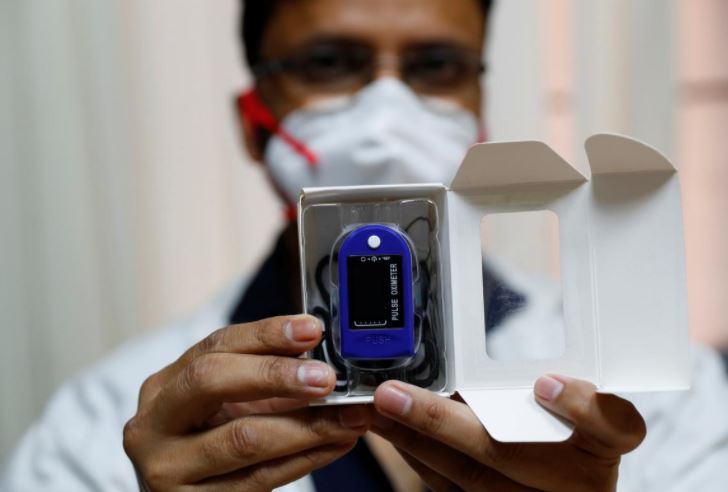
How a $13 device is helping Delhi fight the coronavirus
With 173,000 infections and 4,400 deaths, Delhi now has 14,700 active cases with many hospital beds now empty
NEW DELHI:
Twice a day, New Delhi health worker Kamal Kumari receives a flurry of WhatsApp messages from coronavirus patients, containing either a two-digit reading from a tiny medical device or a photo of its glowing display.
She scans the numbers from the 1,000 rupee ($13) oxygen monitor, known as pulse oximeter, checking to ensure they are all above the prescribed 95 mark and then notes them down in her logbook.
"When we didn't have this, we wouldn't know about their oxygen levels," said Kumari, explaining how her team would worry about patients' conditions rapidly worsening when India's capital was badly short here of hospital beds. "Now we can find out in time and safely refer patients to the hospital."
Delhi’s government has so far distributed pulse oximeters to more than 32,000 people for free, putting them at the heart of a plan to isolate most asymptomatic or mildly symptomatic coronavirus patients in their homes.
The program was devised in May, when coronavirus cases started surging in the densely populated city of 20 million, sending panicked residents rushing to hospitals.
“If we hadn’t done this, there would’ve been no room to even stand in our hospitals,” Delhi’s health minister, Satyendar Jain, told Reuters.
With more than 3.5 million infections, India has reported the world’s third-highest number of coronavirus cases, and states across the country have deployed a variety of measures to fight the pandemic.
In Delhi, health authorities started noticing “happy hypoxemia” - low blood oxygen levels without any breathlessness - that was leading to complications in coronavirus patients isolated at home, Jain said.
For regular monitoring, doctors told Jain that patients would either have to visit hospitals or use the inexpensive oxygen monitors, many of which are made in China.
Delhi has recorded around 173,000 infections with a little over 4,400 deaths. Only 14,700 cases remain active and many hospital beds are now empty.
Proactive monitoring
Other cities across the world have also deployed the device.
In May, at the height of its outbreak, Singapore distributed several thousand oximeters to migrant workers isolated in cramped dormitories, which had become an epicenter for the virus’s spread.
Singapore’s health ministry said oximeters allowed workers “to proactively monitor their own health status and reach out for medical assistance if needed”.
In India, too, other places have picked up on Delhi’s model. Since late July, the northeastern state of Assam has provided nearly 4,000 oximeters to patients in home isolation.
Some doctors are concerned that patients may not always know how to use the device.
“It’s very important to train patients properly on how to use pulse oximeters,” said Dr Hemant Kalra, a pulmonologist in New Delhi, adding that cheap, sub-standard oximeters flooding the market were also a problem.
Jain, however, said the government’s program had worked effectively, with not a single fatality among the thousands of patients in home isolation the last month and a half.
Oximeters have also helped cut down on expensive hospitalisation for mild cases, Jain said, saving more than 10 times the device’s price for each day in hospital.
On a warm, humid day last week, health worker Kumari pulled on a protective suit, a mask and goggles, before walking down the narrow lanes of the Chirag Delhi neighborhood.
Together with a similarly dressed colleague, she stopped at Satish Kumar Soni’s home to check on him and three family members who were ending their 10-day isolation period, and to collect two government-issued pulse oximeters.
Soni, a 59-year-old jeweller, said the device helped the family ease their fears and anxiety as they slowly recovered.
“It’s not that big a disease,” he said. “If the oxygen level is fine, then there isn’t much danger.”




1732105641-0/BeFunky-collage-(78)1732105641-0-270x192.webp)










COMMENTS
Comments are moderated and generally will be posted if they are on-topic and not abusive.
For more information, please see our Comments FAQ